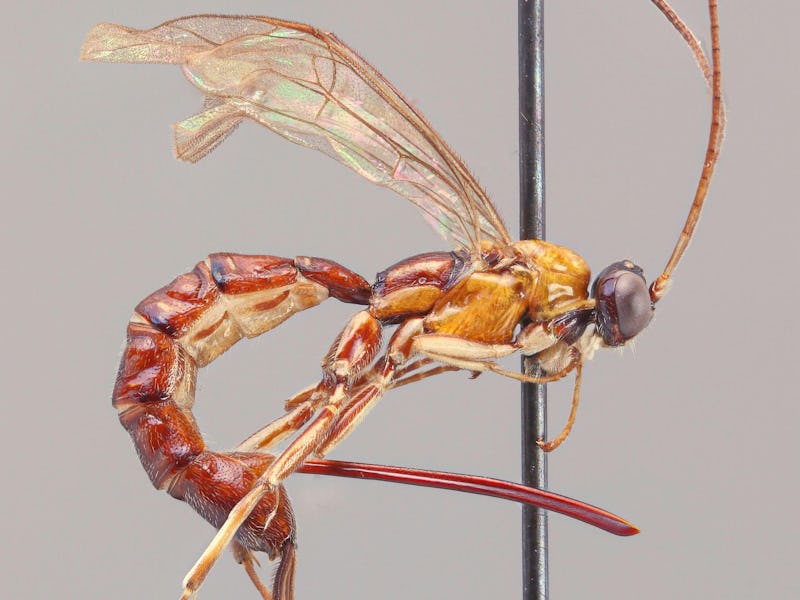Newly Discovered Wasps Add to Growing Family of Terrifying Parasitoids
Their gruesome idea of reproduction involves other warm bodies.

Wasps don’t have the greatest reputation, but that’s probably just because their PR reps have failed to spread the word about all the great stuff they do. Most people just know wasps as little stinging jerks, but the huge variety of beautiful and strange species all over the world actually fulfill all sorts of important roles, like pollinating plants and killing insect pests. Nevertheless, the new discovery of a whole group of uniquely proportioned South American wasps that inject their eggs either into spiders’ egg sacs or inside the spiders themselves probably won’t help their reputation.
In a paper published June 29 in the journal Zootaxa, a team of international researchers laid out descriptions of seven previously undescribed wasp species, all of which belong to the genus Clistopyga.
Clistopyga isayae, like other membrs of its genus, has a wild looking ovipositor, an adapted stinger through which it lays eggs.
What links all of the newly described species is the trademark Clistopyga ovipositor, a long and narrow adapted stinger that the female wasp uses to lay eggs. As parasitoids — organisms that are only parasitic for part of its life cyccle — these insects use other bugs as part of their life cycle. This is where their unique ovipositors come into play, allowing them to reproduce in a particularly gruesome way.
“Females of Clistopyga crassicaudata seek out spiders living in nests and paralyze them with a quick venom injection,” the researchers told Sci-News on Monday. “Then the wasp lays its eggs on the spider and the hatching larva eats the paralyzed spider as well as the possible spider eggs or hatchlings.”
This behavior is similar to other parasitoid wasps, like the Apocrypta westwoodi Grandi, which uses its ovipositor to lay larvae into figs. This wasp’s larvae then eat the larvae of other wasps that are already in there. Brutal.
Close-up view of the ovipositor on a female Clistopyga kalima Palacio .
These seven new species of Clistopyga wasps are still so new that scientists aren’t totally sure about the specifics of their reproductive cycles.
“We do not know for sure which spider this wasp species prefers,” Ilari Sääksjärvi, Ph.D., a professor of biodiversity research at University of Turku in Finland and one of the paper’s co-authors said. What is clear is that they do use their wicked sharp ovipositors to both sting their prey and insert eggs into them. Further research will reveal these mysterious insects’ life cycles.
One wasp in particular, C. crassicaudata — named for the Latin words crassus, for fat, and caudata, for tail — caught Sääksjärvi’s eye:
“The stinger of the new parasitoid wasp called *Clistopyga crassicaudata is not only long but also very wide, in comparison with the size of the species. I’ve studied tropical parasitoid wasps for a long time but I’ve never seen anything like it. The stinger looks like a fierce weapon.”